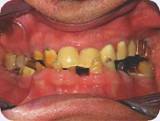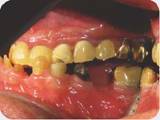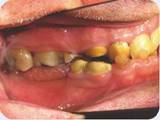
Full mouth rehabilitation—combination of implant and tooth-supported fixed prostheses
In the presence of anatomical limitations, selecting a treatment approach between the placement of implants with preprosthetic surgery and use of natural dentition with implants requires careful consideration and understanding of the biology of the implant system and natural teeth.
CASE STORY
Figure 1: Pretreatment front view.

A 75-year-old male presents with the chief complaint of “I need major work.” Extensive conformative dental treatments were previously rendered, including multiple restorations, acrylic veneered-fixed partial denture, and mandibular overlay-removable partial denture.
Figures and 3: Pretreatment left and right views.
LEARNING GOALS AND OBJECTIVES
Understand the difference in biomechanical characteristics of osseointegrated implant and natural tooth.
Figures 2 and 3: Pretreatment left and right views.


Identify the potential complications involving the combination implant-to-tooth fixed partial denture.
Clinical Cases in Prosthodontics, Leila Jahangiri, Marjan Moghadam, Mijin Choi, and Michael Ferguson, © 2011 Blackwell Publishing Ltd.
Medical History
No contributory finding noted
Dental History
Conformative dental treatments over the years
Clinical Findings/Problem List
Generalized wear patterns (attrition and abrasion)
15 mm loss of vertical dimension of occlusion
Overcontoured restorations
Generalized moderate to severe plaque and calculus accumulation
Bleeding upon probing
Generalized grade 2+ clinical mobility except the maxillary right quadrant
I nadequate posterior support
Absence of anterior guidance
Occlusal plane discrepancy
Radiographic Findings
Caries
Moderate to severe bone loss
Furcation involvement
Widened PDL
Defective restorations (open margins and overcontoured restorations)
Diagnosis
Defective existing restorations and prostheses
Caries
Loss of vertical dimension of occlusion
Generalized moderate to severe adult periodontitis
Partial edentulism
Parafunctional habit
Pseudo-class III malocclusion
Clinical Decision-Making Determining Factors
Biomechanical characteristics of a natural tooth (Cohen and Orenstein 1994) include its ability to exhibit and tolerate minor movement of 50200 |xm. This is as a result of the presence of periodontal ligaments and their viscoelastic properties.
Osseointegrated implants (Ericsson, Glantz et al. 1988) show approximately 10 |m of mobility that results from the flexure and elastic deformation of surrounding bone when subjected to forces.
When implants are rigidly connected to natural tooth/teeth, there is an observed greater bone loss around the implant. This suggests that implant overload and bone loss may result from the natural tooth acting as a cantilever (Skalak 1983; Ericsson, Lekholm et al. 1986; Sullivan 1986). Use of nonrigid connectors in the implant-teeth fixed partial denture system has also shown to be unfavorable and places stress on the implant system and prosthesis (Lin, Chang et al. 2006). Although there is a lack of consensus on this issue, current clinical evidence i/>
Stay updated, free dental videos. Join our Telegram channel

VIDEdental - Online dental courses


